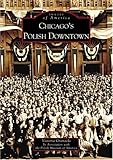
Average Reviews:

(More customer reviews)Size doesn't always matter. Sixty years ago, the head of the world's biggest country sneered at the number of divisions of the world's smallest country. Half a century later, that leader and that state found themselves in the dustbin of history, consigned there in no small measure, many claim, by their Lilliputian adversary. Size does not matter as much as influence. The Vatican may be smaller than many American farms, but those 106 acres are influential far beyond Bernini's Colonnade.
The same can be said, with regard to American Polonia, about Chicago's Polish downtown.
As Victoria Granacki points out, Chicago's Polish downtown (which is actually on the city's northwest side) was more or less bounded by Ashland, Division, and Milwaukee Avenues "and stretched for not much more than a half mile in any direction" (p. 6). But size doesn't matter: the influence of those blocks on the history of American Polonia is inestimable. Granacki does not exaggerate when she sums up that history thusly: "[T]hough the physical size of the neighborhood was compact, its influence was far-reaching. Nearly all Polish undertakings of any consequence in the United States through the world wars either started in or were directed from this tight-knit neighborhood in Chicago" . . . , a neighborhood she rightly dubs "the capital of American Polonia" (p. 7).
Granacki documents the history of that enclave through the genre peculiar to the "Images of America" series: pictures. Approximately 100 vintage photographs, mostly from "Polonia's Smithsonian," the Polish Museum of America, adorn the pages, telling the story of "the capital of American Polonia" through its churches (St. Stanislaus Kostka, Holy Trinity, St. John Kanty, St. Mary's, St. Hedwig's and Holy Innocents), its secondary schools (including St. Stanislaus "College," an institution that spanned the distinction between high school and junior college) and its charitable institutions (like St. Mary of Nazareth Hospital and the old age homes served by the Franciscan Sisters of Bl. Cunegunda, a religious order founded in this neighborhood by a young Polish immigrant, Sr. Mary Theresa Dudzik, who is now a candidate for the altars). Since this enclave was the "capital of American Polonia," one cannot tell its story without allusions to the history of American Polonia in general, and nowhere is this more evident than in the chapter on "Polish organizations." The Polish Roman Catholic Union and the Polish Museum of America, the Polish National Alliance (PNA) and the Polish Women's Alliance-three of the big four fraternals-all are or at one time were headquartered there. The first nest of the Polish Falcons was founded there. Behind the great national fraternals were their newspapers-Dziennik Chicagoski, Zgoda, Dziennik Zwi¹zkowy-all of which were published there.
The commentary on these photographs is substantial: it situates the events, persons, or institutions historically. The tone of the book is celebratory: Chicago's Polish downtown was, after all, the "capital of American Polonia" and most tributes to capitals rarely mention their seedier sides. (What table books of Washington, for example, include Anacostia or parts of Northeast?) Indeed, there's even a chapter on "Processions, Parades, Events and Celebrations," documenting annual events like the Constitution Day Parade or Polish Day as well as once-in-a-lifetime happenings like PNA President Casimir Zychliñski's 1927 funeral (nobody marks a funeral like a Pole). But if the reviewer had to identify one criticism of the book, it's that downplaying of the seedier side. For many Americans, Slavic Chicago is identified with Upton Sinclair's grim meatpacking plants described in The Jungle.. The socialist Sinclair may have overplayed the "downtrodden masses," but Poles often go to the other extreme. Granted, Granacki shows the humble houses of average Poles (pp. 2, 86-87) and even shows some of the small Polish businesses (like the sausage factories, p. 85), but the greyer side of everyday life lived by these bottom-rung-on-society's-social-ladder immigrants fades into the background. I have no idea if there were mega-meat packers in this area of Chicago, but I do think we Polonians sometimes underplay the grimmer sides of immigrants' struggles when documenting just how much they contributed to America. My other criticism of this book is that no pictures carry us into today's Polish downtown. Granted, the neighborhood reigned as "capital of American Polonia" in "the first half of the twentieth century" (p. 7) and the neighborhood's changed since then. But some documentation of that change would benefit readers. Happily, the book ends with a map and suggested walking tour of the downtown, "On Foot in Old Polonia" (pp. 123-25).
These minor reservations aside, the book is recommended not just for Chicago Polonia (a not insignificant market since, except for Warsaw, no city in the world has more Poles) but for all Polish Americans. For just as Washington, D.C., is the heritage of all Americans, so these few blocks in Chicago's Polish downtown is the heritage of all Polonians.
Click Here to see more reviews about: Chicago's Polish Downtown (IL) (Images of America)
Polish Downtown is Chicago's oldest Polish settlement and was the capital of American Polonia from the 1870s through the first half of the 20th century. Nearly all Polish undertakings of any consequence in the U.S. during that time either started or were directed from this part of Chicago's near northwest side.This book illustrates the first 75 years of this influential Polish neighborhood. Featured are some of the most beautiful churches in Chicago-St. Stanislaus Kostka, Holy Trinity, and St. John Cantius-stunning examples of Renaissance and Baroque Revival architecture that form part of the largest concentration of Polish parishes in Chicago. The headquarters for almost every major Polish organization in America were clustered within blocks of each other, and four Polish-language daily newspapers were published here. The heart of the photographic collection in this book is from the extensive library and archives of the Polish Museum of America, still located in the neighborhood.
Click here for more information about Chicago's Polish Downtown (IL) (Images of America)

No comments:
Post a Comment